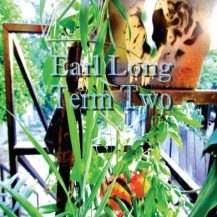Earl Long — “Term Two”
Grafton gives Earl Long’s September release a 9.5 out of 10! You gotta check the record out now.
Grafton Tanner
9.5
out of 10
Earl Long
Term Two
September 5, 2013
Self Released
Dig around the New Orleans music scene long enough, and you will likely hear of Ray Bong. He functions as the NOLA figurehead of all things “townie,” something many of the great music cities have. We bestow local fame onto Ray and these cultural icons who are usually eccentric, over 40 years old, and often spotted at the hippest events in the hippest towns, and in return, we are given history lessons, wisdom, suggestions for the best local microbrew, and occasionally, an off-color knee slapper or two to tell our friends.
Enter: Ray Bong, experimental musician and NOLA local legend at the heart of Earl Long. Named after the 45th Governor of Louisiana, Earl Long is an abstract exercise in timeless avant-garde following in the lineage of the great 70s psychedelic noisemakers. Such labels will prove meaningless when you drop the needle on track one, but Term Two is at times free jazz, sludge, and lo-fi early electronic music. It’s This Heat and The Thing. It’s Can and Captain Beefheart. If Term Two was “largely improvised,” then all this coding is futile, for the end result is a remarkably diverse and adventurous release regardless of possible influences.
What immediately distinguishes Term Two is the lo-fi quality of the recording, and the decision to record at a New Orleans record store instead of a more apt studio location not only follows with the free form of the record but also coats the entire mix in the inviting warmth of analog. Listening to it from top to bottom is surreal and oddly comforting in a way that is like hearing The Caretaker’s An Empty Bliss Beyond This World or any of Ariel Pink’s early recordings for the first time. The subdued nostalgia of pre-digital recording sounds perfectly rounded out with each instrument nestled just so in the space of the recording.
With six of the eight tracks at or under the three-minute mark, Term Two is concise in length but enormous in scope. The old filmmaking maxim of arriving at the scene late and getting out early definitely applies here as most tracks begin with little to no introduction and end with a rapturous climax. “Bosun’s Mate” starts with a fiery start-and-stop sludge beat and ends with the kind of wild psychedelic freak out that would fit nicely on Trout Mask Replica. “Tuk-Tuk” takes cheesy keyboard presets and pairs them with analog bloops and bleeps in the vein of Stockhausen and provides a brief respite from the jazzy horror of the preceding tracks. Earl Long dips into bluesy terrain with the first half of “Professor John Plays the Harmonica/Spider Eggs on Your Face,” an album highlight that opens with a haunting harmonica cadenza played by John the Harmonica Man. It is eerie and abrasive like hearing some long-forgotten blues musician honking on a warped and antiquated medium – near but virtually at a distance. And it ends up in an entirely alien location as saxophone and guitar slither over one another and then erupt in a roaring conclusion. It’s the most unsettling moment on an album that constantly wrenches you from wandering dreamscape to furious frenzy, track after track.
Make no mistake – Term Two is a technically impressive workout that will satisfy lovers of the virtuosic, and much of this virtuosity can be traced to the musicians who compose Earl Long. The album credits such giants as the elusive Suzy Creamcheese (of Frank Zappa fame), bassist extraordinaire Brian Bromberg, and saxophonist Sylvain Roudier. This is a roster of first class musicians with quite the resumes. Though Term Two may look like abstract wanking-for-the-sake-of on paper, it sounds like the collaborative fruit from some of the most imaginative artists working today.
It’s no coincidence that the first and last songs on Term Two are called “Right Brain (Left Brain)” and “Brain Folds (Right/Left).” Earl Long want to hit your heart and your mind with music that is both abstract and euphonic, beautiful and ugly. It is unlike most of what you will hear released this year and, like Ray Bong himself, embodies the rich history of New Orleans, concocted by a bizarro gathering of dynamic artists pushing outward to new sonic extremes.
-Grafton Tanner, December 11, 2013